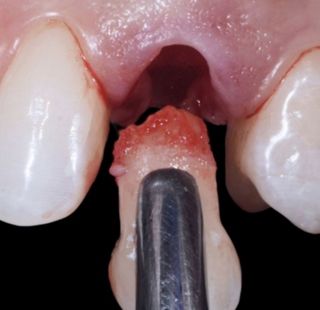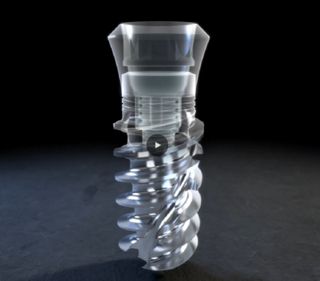
Photo from the (beautiful!) case presentation by Dr. Piano on youTooth
Taking immediacy to the next level
Patients prefer shorter treatment times, with less surgery involved. As evidence grows for immediate protocols the stage is set for ImmediaXy by Straumann®.
Immediate design reloaded
With its conical and progressively threaded screw design the Straumann® TLX is ideally suited for immediate placement and restoration. The endosteal part of the implant is identical with the Straumann® BLX bone level optimized for immediacy. Both implants are based on the high-strength material Roxolid® and the hydrophilic SLActive® surface designed for excellent healing capacity. This is combined with the slim and fully tapered core and the minimized shoulder diameter. Both features facilitate the preparation of undersized osteotomies and reduce the need for augmentation, depending on the individual situation4.

Features and benefits
Straumann® developed the TLX Implant System for efficient protocols, both from a surgical and prosthetic point of view.
To achieve the high primary stability necessary for immediate placement and restoration, the Straumann® TLX has a conical and progressively cutting thread design5, 6. This is combined with a dynamic flute for the collection and condensing of bone chips during preparation, and bi-directional elements for reverse and forward cutting. Together with the deep apical threads designed for maximum engagement and stability, these features facilitate insertion, especially in immediate placement cases.
Scan your patient
All treatments start with taking a detailed history and clinical examination of the individual patient. This is also true for therapy using the Straumann® digital ecosystem, which is consistently integrated with the TLX (“born digital”). Following intra-oral or model-based scans and, if indicated, a cone beam computed tomography scan, the resulting data can be synchronized in a planning program like Straumann® coDiagnostiX® to find a clinically sound and minimally invasive protocol (Fig. 1). Again, both the narrow 3.75 mm diameter and the progressive thread design of the TLX are streamlined with this clinical approach.
Learn more about the potentials of the Straumann® TLX Implant System:
Photos (Figs. 1-3) courtesy of Dr. Matthieu Collin (France) see case report here
Prosthetic versatility
The TLX Implant System is an integral part of the versatile and proven Straumann® prosthetic portfolio. As in the BLX Implant System, the TLX has also been equipped with the TorcFit™ implant-abutment connection optimized for digital workflows. This interface allows easy placement of abutments at soft tissue level and, alternatively, easy handling of direct-to-implant restorations.
Screw-retained solutions facilitate retrieval e.g., for maintenance, and reduce concerns about peri-implant inflammation. Based on the open CADCAM platforms, either validated Straumann® or external workflows can be realized. This relates to both single-gap (Figs. 4-6), partially edentulous and full-arch (Figs. 2, 3) implant-retained restorations, in both straightforward and advanced cases.
Photos (Figs. 4-6) courtesy of doctors Waldemar Polido, Wei-shao Lin and Dean Morton (USA) see case report here

Want to stay up to date?
youTooth.com is THE PLACE TO BE IN DENTISTRY – subscribe now and receive our monthly newsletter on top hot topics from the world of modern dentistry.
